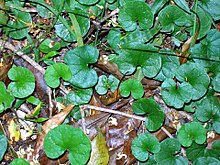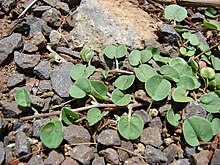Dichondra
| Dichondra | ||||||||||||
|---|---|---|---|---|---|---|---|---|---|---|---|---|

Dichondra micrantha |
||||||||||||
| Systematics | ||||||||||||
|
||||||||||||
| Scientific name | ||||||||||||
| Dichondra | ||||||||||||
| JR Forest. & G.Forst. |
Dichondra is a plant genus of the family of wind plants (Convolvulaceae). The 15or so species are widespread in the tropics and subtropics.
description
Dichondra are herbaceous plants that usually grow prostrate. They are hairless or silky hairy. The small leaves are heart-shaped, circular or kidney-shaped, with entire margins and long-stalked.

The small flowers stand individually in the armpits and are petiolate. The sepals are almost the same size, stand free and are mostly spatulate. The crown is broadly bell-shaped, deeply five-lobed, the lobes are folded inward. The stamens are shorter than the crown, the stamens are awl or thread-shaped, the anthers are small. The ovary is leaved, the two carpels are free from one another, each contain two chambers, each with two ovules . The two styluses stand between the carpels, they are thread-shaped, the scars are head-shaped.
Two separate capsules are formed, which are membranous and usually contain only one seed . The capsules do not pop open or are irregularly two-lobed. The seeds are almost spherical and smooth. The cotyledons are elongated-linear and folded in two.
Systematics
The genus is classified within the bindweed family in the tribe dichondreae . About 15 species are distinguished within the genus:
- Dichondra argentea Willd. : The distribution area includes the southern USA, Mexico and ranges from Colombia and Bolivia to northwestern Argentina.
- Dichondra brachypoda Wooton & Standl. : The distribution area includes southern Brazil and Mexico and also extends from Arizona to Texas.
- Dichondra brevifolia Buchanan : Home is New Zealand.
- Dichondra carolinensis Michx. : The distribution area includes the Bermuda Islands and extends from the southeastern USA to Texas.
- Dichondra donelliana Tharp & MCJohnst. : The home is California and southwest Oregon.
- Dichondra evolvulacea (Lf) Britton : The home is Colombia.
- Dichondra macrocalyx Meisn. : The distribution area extends from Bolivia and eastern and southern Brazil to northern Argentina and Paraguay.
- Dichondra micrantha Urb. : The home is the islands of the Caribbean and Mexico to Texas. As a neophyte, the species is also transported around the world and is also found in Europe.
- Dichondra microcalyx (Hallier f.) Fabris : The distribution area extends from Ecuador to southern South America.
- Dichondra nivea (Brandegee) Tharp & MCJohnst. : The home is Mexico.
- Dichondra occidentalis House : Home is southwest California and Baja California .
- Dichondra parvifolia Meisn. : The home is Bolivia and southern Brazil.
- Dichondra recurvata Tharp & MCJohnst. : The home is Texas.
- Dichondra repens J. R. Forst. & G. Forst. : The homeland is Macaronesia, New Zealand and southern and eastern Australia.
-
Dichondra sericea Sw. : With three varieties:
- Dichondra sericea var. Holosericea (O'Donnell) Fabris : It occurs in southern South America.
- Dichondra sericea var. Sericea : The range extends from Arizona to Central America and from Ecuador and Bolivia to southern Brazil and southern South America.
- Dichondra sericea var. Tomentosa W.R.Buck ex Tronc. & Bacigalupo : It occurs in Uruguay and northeast Argentina.
swell
Individual evidence
- ^ Saša Stefanović, Daniel Austin and Robert Olmstead: Classification of Convolvulaceae: A Phylogenetic Approach. In: Systematic Botany , Volume 28, Number 4, 2003. pp. 791-806. doi : 10.1043 / 02-45.1 (currently unavailable) ( online )
- ↑ a b c d e f g h i j k l m n o p q r Rafaël Govaerts (Ed.): Dichondra. In: World Checklist of Selected Plant Families (WCSP) - The Board of Trustees of the Royal Botanic Gardens, Kew . Retrieved January 5, 2020.
literature
- Henri Alain Liogier : Descriptive Flora of Puerto Rico and Adjancent Islands. Spermatophyta-Dicotyledoneae. Volume 4: Melastomataceae to Lentibulariaceae. Universidad de Puerto Rico, Río Piedras 1995, ISBN 0-8477-2337-2 .



